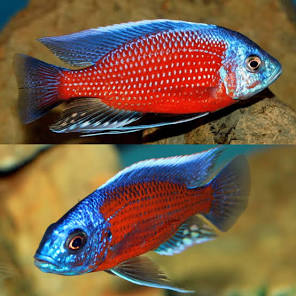Midwest Aquarium and Pond Supplier LLC
(105)Red Kadango 3in
(105)Red Kadango 3in
Precio habitual
$100.00 USD
Precio habitual
Precio de oferta
$100.00 USD
Los gastos de envío se calculan en la pantalla de pago.
Cantidad
No se pudo cargar la disponibilidad de retiro
The Red Kadango, or Red Fin Kadango Cichlid (Copadichromis borleyi), is a popular African cichlid from Lake Malawi. It is a desirable aquarium fish due to its relatively peaceful temperament, vibrant coloration, and open-water swimming habits
Appearance
- Male: Develops a shimmering metallic blue head and body with vibrant orange-red highlights and fins.
- Female: Remains smaller and less colorful, typically a silver or beige color.
- Size: This species grows to about 6 to 8 inches in captivity.
Tank and water requirements
- Tank size: A minimum of a 75-gallon tank is recommended for a small group, with larger tanks being ideal for managing territorial aggression and providing ample swimming space.
- Substrate: A sand or fine gravel substrate is ideal.
- Filtration: A robust filtration system is essential to handle their bioload and maintain the high water quality they require.
-
Water parameters:
- Temperature: Maintain a stable temperature between 75 and 82°F (24–28°C).
- pH: A high pH of 7.8–8.6 is necessary to replicate their native Lake Malawi habitat.
- Decorations: Aquascape with plenty of rocks, caves, and crevices to create territories and hiding places. Leave open swimming areas in the middle of the tank.
Diet and feeding
- Omnivorous diet: The Red Kadango is an omnivore that, in the wild, feeds on zooplankton.
- Food types: In the aquarium, provide a varied diet of high-quality cichlid flakes or pellets. Supplement with small portions of foods that mimic zooplankton, such as brine shrimp, mysis shrimp, and cyclops.
- Feeding schedule: Feed once or twice daily, ensuring all food is consumed within a few minutes.
Temperament and tank mates
- Semi-aggressive: Red Kadangos are generally peaceful compared to other African cichlids, but males can be territorial, especially when breeding.
- Social dynamics: It is best to keep one male with several females to disperse aggression.
- Tank mates: They are best kept with other similarly sized and tempered African cichlids from Lake Malawi, such as other haps and peacocks. Avoid highly aggressive mbunas.
Breeding
- Maternal mouthbrooders: Like other peacocks and haps, the female carries the fertilized eggs and fry in her mouth for protection, usually for about 3 to 4 weeks.
- Spawning behavior: Males will dig a small pit or clean a flat rock surface to entice females to spawn.
- Raising fry: To protect the fry, you can move a holding female to a nursery tank, as the fry are large enough to accept finely crushed flake food or newly hatched brine shrimp when they are released
Share
No reviews

